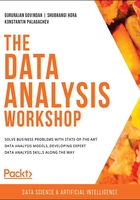
Introduction
In the previous chapter, we looked at various techniques to do with probability theory and hypothesis testing, which are often applied in data analysis. In this chapter, we will extend our knowledge by introducing mathematical models that are suitable for both data analysis and predictions. In this way, we will obtain the fundamental tools for deriving explanatory models and provide a generic framework for identifying causalities and effects when performing data analysis.
Direct marketing campaigns are a classical approach to increasing business revenue, informing potential customers about new products, and merchandising them. Having targeted marketing campaigns can significantly increase success rates and revenue since the audience is based on precise criteria and the analysis of past marketing campaigns. Thus, extracting information about successful campaigns and customers can significantly reduce marketing costs and increase sales.
In this chapter, we will analyze data from the direct marketing campaign of a Portuguese banking institution based on phone calls that were performed between May 2008 and November 2010. We will not only use the techniques presented in the previous chapters but will introduce new concepts, such as linear and logistic regression, that are widely used in data analysis and predictive modeling (predictive modeling being the process of using data patterns to predict future outcomes). These types of models have several advantages, but two of the most important ones are their simplicity and interpretability.
Note
The original dataset can be found here: https://archive.ics.uci.edu/ml/datasets/Bank+Marketing.
You can also find it in our GitHub repository at: https://packt.live/2UOmIyp.
For further reading on this topic, refer to the following article: [Moro et al., 2014] S. Moro, P. Cortez and P. Rita. A Data-Driven Approach to Predict the Success of Bank Telemarketing. Decision Support Systems, Elsevier, 62:22-31, June 2014.
The scope of the marketing campaign is selling long-term deposits. For each call, information about the client and the outcome of the call is registered. For instance, client information contains family and education status and the client's current financial situation (the data is anonymized). Information about the last call from the previous marketing campaign is also registered. In this way, we have a clear picture of the type of client that has been contacted, as well as information about the historical outcome from previous marketing campaigns.